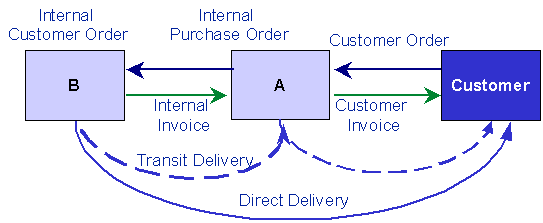Inter-Site Address Handling
This document describes the specific use of the following fields within the inter-site order feature. The fields below, are also sometimes referred to as the EAN location number.
- Company's Own Address ID
- Customer's Own Address ID
Basic data for the aforesaid fields, must be maintained as follows:
- Enter the Company's Own Address ID on the Company/Address tab.
- Enter the Customer's Own Address ID on the Customer/Address tab.
When sourcing an external customer order internally, there are two different scenarios depending on the material flow.
- Transit delivery: When the internal supply site sends goods to the demand site, and this site in turn sends them further to the end customer.
- Direct delivery: When the internal supply site sends goods directly to the end customer.

Internal Purchase Direct
A customer orders goods from site A. Site A does not have available inventory, but places an internal purchase order with a direct delivery of goods. The goods will be sent from site B to the external customer. In this situation, site A is the ordering customer while the external customer is the deliver-to customer. To identify the deliver-to address (the external customer's address) at site B when the internal customer order is being created, the external customer's address must have the Customer's Own Address ID field set in the customer catalogue. This makes it possible for the system to find the correct address even if the two sites operate in different database instances. The address is a known address and will not be selected as a single occurrence.
When the external customer order is released at site A and the internal purchase order is created, the values in the Deliver-to-Customer and the Customer's Own Address ID fields are saved on the purchase order line. These two fields, among other information, are then transferred via message handling to the supply site, site B in the example.
Internal Purchase Transit
A customer orders goods from site A. Site A does not have available inventory but places an internal purchase order with a transit delivery of goods. The goods will be sent from site B to site A, and then from site A to the external customer. In this situation, site A is the ordering customer as well as the deliver-to customer. On the internal purchase order, the ordering customer is a site, and it is the site's delivery address that will be retrieved as the deliver-to address. However, on the internal customer order, the deliver-to address is retrieved from the customer catalogue for site A as the customer. To identify the deliver-to address (the internal customer's address) at site B when the internal customer order is being created, the internal customer's address must have set a value in the Customer's Own Address ID field in the customer catalogue. This must be exactly the same ID as in the Company's Own Address ID field for site A. In this way, it is possible for the system to find a link between the site's address on the purchase order and the internal customer's address on the internal customer order. The address is a known address and will not be selected as a single occurrence.
Note: This link between the two addresses is also important in order to find the correct route between site B and site A (if any). This way, the order promising towards the external customer will be based on the correct route departure date.
Internal Purchase
An internal purchase order does not necessarily have to originate from a customer order; it can be entered directly as an internal purchase order. However, this scenario works exactly in the same way as the transit scenario described above, but the starting point is the purchase order instead of the customer order.